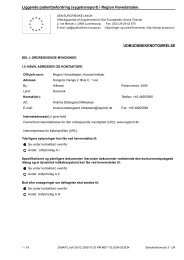Territorial Review Copenhagen - Region Hovedstaden
Territorial Review Copenhagen - Region Hovedstaden
Territorial Review Copenhagen - Region Hovedstaden
You also want an ePaper? Increase the reach of your titles
YUMPU automatically turns print PDFs into web optimized ePapers that Google loves.
159<br />
types entering the central Congestion Charge Zone was consistently 16% lower<br />
in 2006 than the pre-charge levels in 2002. TfL also reported improvement of air<br />
quality in the zone. TfL‘s annual report for 2006-7 shows that revenues from the<br />
congestion charge were GBP 252.4 million over the financial year (8.5% of<br />
TfL‘s annual revenue). It spent more than half the revenue on the operating costs<br />
of the charging system. After deducting the operating costs and the other<br />
charges, net income was GBP 89.1 million. Law requires that the TfL spend all<br />
net income raised through the charge on reinvestment in London‘s transportation<br />
infrastructure. The TfL invested about 80% of net income in bus network<br />
improvements. As a result, new routes were introduced and existing routes<br />
extended, and frequency of service increased. As a result, bus use increased in<br />
the central London Area.<br />
From October 2008, the GLA will introduce a completely new charging<br />
structure. The new system will charge cars based on potential CO 2 vehicle<br />
emissions. Cars and certain pickup trucks will be charged GBP 25 a day, while<br />
low-emission cars will be free of charge.<br />
Stockholm: Stockholm introduced a congestion charge on a permanent basis<br />
in August 2007, after a seven-month trial period between January 2006 and July<br />
2006. The charged area covers Stockholm City Centre. The trial was successful,<br />
with reduced traffic and improved air quality. Before the national government<br />
made this decision, municipal governments held a referendum regarding the<br />
permanent introduction of the congestion charge. The result in the municipality<br />
of Stockholm was 53% support for the charge. However, the surrounding<br />
municipalities unanimously disapproved of the introduction of the charge,<br />
voting against it by between 54.1% and 70.4%. Many residents in the<br />
surrounding municipalities commuted to the congestion charge area and were<br />
heavily influenced by the charge. After the referendum, the government took the<br />
result in the municipality of Stockholm into consideration and implemented the<br />
congestion charge.<br />
The national government introduced the congestion charge as a tax and has<br />
managed the revenue. The government will use the revenue entirely for new<br />
road construction in and around the Stockholm area, including the construction<br />
of a new major bypass road, while the government spent all the revenue on<br />
public transport in Stockholm during the trial period.<br />
Norway: Congestion pricing in Norway is different from that in London and<br />
Stockholm, and is levied as tolls in the main corridors ―ring road‖ rather than as<br />
an area-based charge. Though it was initially intended to raise revenue to<br />
finance the ring road, it created the same impact as a congestion charge. The<br />
revenue has also provided funds for improvements in public transport and<br />
environmental projects.<br />
Singapore: Singapore has the world‘s most sophisticated and long-standing<br />
congestion charge system, thanks to the small geographic area of the city state<br />
(42 kilometres east to west and 23 kilometres north to south) and to the strong<br />
political will of the dominant political party. The fare is automatically charged<br />
depending on the time, place and vehicle type. This is the most developed type

















